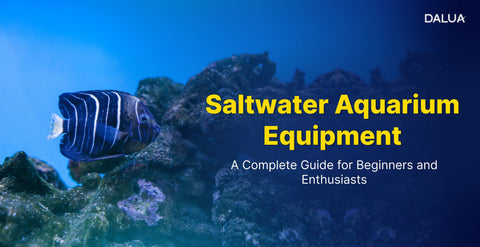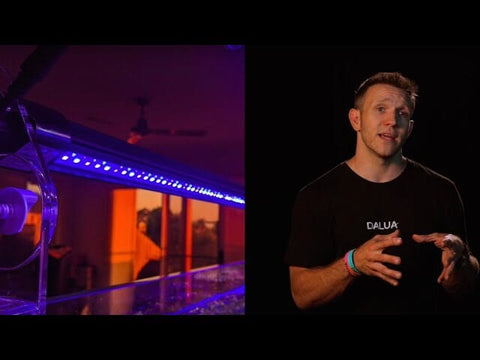Saltwater Aquarium Equipment: Your Complete Setup Guide
Setting up a saltwater aquarium is more than placing fish in a tank. The right equipment is the foundation of a stable, healthy marine environment. In this guide, we’ll walk you through the core gear you need, how to choose it, where to place it, and some pro tips to make your reef or fish-only tank stable and low stress.
This article lives on Dalua — your go-to source for quality marine aquarium gear dalua.com.
Why Good Equipment Matters
Saltwater systems are more demanding than freshwater. You’re managing salinity, dissolved organics, coral nutrients, and sensitive invertebrates. Poor or under-sized gear leads to parameter swings, algae blooms, or fish stress. Investing smartly up front saves you from costly mistakes later.
Essential Equipment for a Saltwater Aquarium
Here’s a breakdown of the core equipment categories and what to look for:
Tank + Stand + Overflow / Plumbing
- Choose a size you can support and maintain. Bigger tanks are more stable (fluctuate less).
- The stand must be rigid, level, and water-resistant.
- Use bulkheads, overflow boxes, or drilled setups to route water to a sump or filtration area.
- Plan plumbing with soft tubing or rigid PVC with gentle curves (avoid sharp bends)
Filteration System
- Mechanical (filter socks, sponges, floss) to catch particles
- Biological (live rock, bio-media, refugium) to host beneficial bacteria
- Chemical (activated carbon, phosphate removers) for polishing
- Many setups use a sump or refugium to hide and expand filtration capacity
Protein Skimmer
This device removes dissolved organics before they degrade. A properly sized skimmer reduces nitrate buildup and helps water clarity.
Pumps & Water Flow Devices
- Return pump: pushes water from the sump back to display
- Powerheads / wave makers: for circulation inside the display
- Choose pumps rated for head height plus “safety margin”
- Place strategically to avoid dead zones and simulate reef currents
Lightings
- For fish-only systems, moderate lighting is enough
- For coral, especially SPS, you need high quality LED or T5 lighting with correct spectrum and intensity
- Adjust photoperiod and intensity carefully — too much light leads to algae, too little stresses corals
Heater/Chiller/Climate Control
- A good aquarium heater with reliable thermostat is a must
- In warm climates or under intense lighting, a chiller may be required
- Insulate plumbing or provide cooling fans where needed
Salinity & Water Quality Tools
- Refractometer or high-quality digital salinity meter
- Test kits for ammonia, nitrite, nitrate, pH, alkalinity, calcium, magnesium
- TDS/EC meter if using RO/DI water
- Auto Top-Off (ATO) system to maintain water volume and salinity
RO/DI Water Filtration System
To start, run water free of chlorine, heavy metals, and contaminants. An RO/DI unit
ensures pure water, which you then mix with marine salt to reach ideal salinity. Many aquarists use this system to prepare new water for changes.
Substrate & Live Rock / Decor
- Live rock acts as both aesthetic and biological filtration
- Sand or crushed coral substrate can host beneficial fauna
- Choose inert or reef-safe decor
Controllers, Monitors & Backup Power
- Aquarium controllers (with probes, alarms) provide real-time tracking
- Power timers, surge protectors, drip loops (prevent water reaching outlets)
- Backup power (UPS or generator) in case of outages
- Monitoring devices (temperature, pH, ORP) help you catch issues early
Equipment Placement & Layout Tips
- Keep gear accessible for maintenance and cleaning.
- Mount controllers and power strips above expected water splash levels and include drip loops.
- Place pumps, skimmers, and sensors low in the sump.
- Arrange tubing to minimize turbulence and avoid suction points.
- Use quieter routes for plumbing (e.g. under stand) to minimize visual clutter in display.
Pro Tips for Long-Term Stability
- Start slow: run the system (cycling) before adding livestock.
- Don’t overbuy immediately—upgrade only when needed.
- Clean equipment regularly (e.g. vinegar soak for skimmer parts, inspect pump impellers).
- Monitor parameters weekly and log results to spot drift.
- Build in redundancy: multiple circulation pumps, backup heater, backup CO₂-free water source.
- When you upgrade one part, consider how it affects the rest (e.g. stronger lighting may require more cooling).




